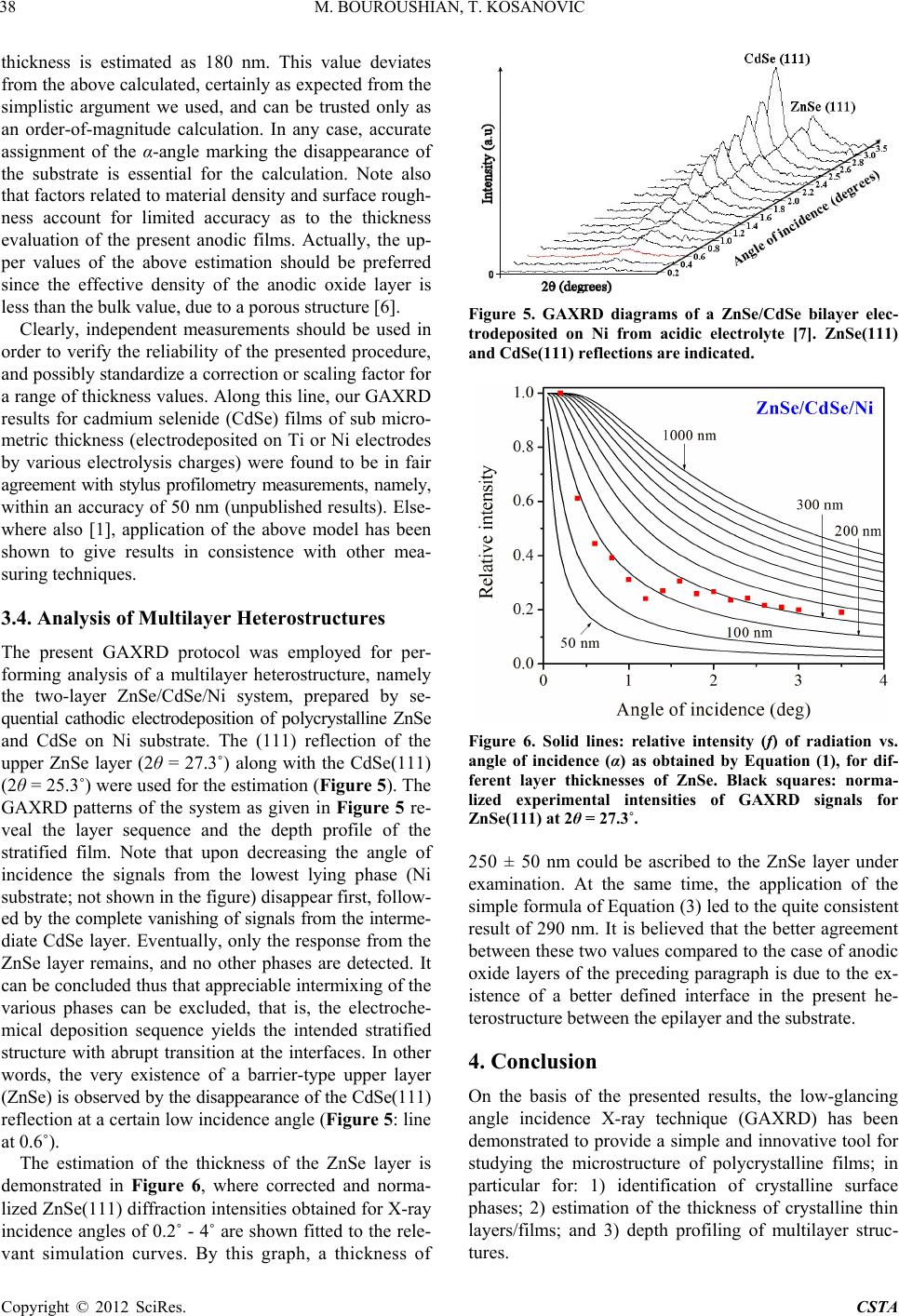
M. BOUROUSHIAN, T. KOSANOVIC
38
thickness is estimated as 180 nm. This value deviates
from the above calculated, certainly as expected from the
simplistic argument we used, and can be trusted only as
an order-of-magnitude calculation. In any case, accurate
assignment of the α-angle marking the disappearance of
the substrate is essential for the calculation. Note also
that factors related to material density and surface rough-
ness account for limited accuracy as to the thickness
evaluation of the present anodic films. Actually, the up-
per values of the above estimation should be preferred
since the effective density of the anodic oxide layer is
less than the bulk value, due to a porous structure [6].
Clearly, independent measurements should be used in
order to verify the reliability of the presented procedure,
and possibly standardize a correction or scaling factor for
a range of thickness values. Along this line, our GAXRD
results for cadmium selenide (CdSe) films of sub micro-
metric thickness (electrodeposited on Ti or Ni electrodes
by various electrolysis charges) were found to be in fair
agreement with stylus profilometry measurements, namely,
within an accuracy of 50 nm (unpublished results). Else-
where also [1], application of the above model has been
shown to give results in consistence with other mea-
suring techniques.
3.4. Analysis of Multilayer Heterostructures
The present GAXRD protocol was employed for per-
forming analysis of a multilayer heterostructure, namely
the two-layer ZnSe/CdSe/Ni system, prepared by se-
quential cathodic electrodeposition of polycrystalline ZnSe
and CdSe on Ni substrate. The (111) reflection of the
upper ZnSe layer (2θ = 27.3˚) along with the CdSe(111)
(2θ = 25.3˚) were used for the estimation (Figure 5). The
GAXRD patterns of the system as given in Figure 5 re-
veal the layer sequence and the depth profile of the
stratified film. Note that upon decreasing the angle of
incidence the signals from the lowest lying phase (Ni
substrate; not shown in the figure) disappear first, follow-
ed by the complete vanishing of signals from the interme-
diate CdSe layer. Eventually, only the response from the
ZnSe layer remains, and no other phases are detected. It
can be concluded thus that appreciable intermixing of the
various phases can be excluded, that is, the electroche-
mical deposition sequence yields the intended stratified
structure with abrupt transition at the interfaces. In other
words, the very existence of a barrier-type upper layer
(ZnSe) is observed by the disappearance of the CdSe(111)
reflection at a certain low incidence angle (Figure 5: line
at 0.6˚).
The estimation of the thickness of the ZnSe layer is
demonstrated in Figure 6, where corrected and norma-
lized ZnSe(111) diffraction intensities obtained for X-ray
incidence angles of 0.2˚ - 4˚ are shown fitted to the rele-
vant simulation curves. By this graph, a thickness of
Figure 5. GAXRD diagrams of a ZnSe/CdSe bilayer elec-
trodeposited on Ni from acidic electrolyte [7]. ZnSe(111)
and CdSe(111) reflections are indicated.
Figure 6. Solid lines: relative intensity (f) of radiation vs.
angle of incidence (α) as obtained by Equation (1), for dif-
ferent layer thicknesses of ZnSe. Black squares: norma-
lized experimental intensities of GAXRD signals for
ZnSe(111) at 2θ = 27.3˚.
250 ± 50 nm could be ascribed to the ZnSe layer under
examination. At the same time, the application of the
simple formula of Equation (3) led to the quite consistent
result of 290 nm. It is believed that the better agreement
between these two values compared to the case of anodic
oxide layers of the preceding paragraph is due to the ex-
istence of a better defined interface in the present he-
terostructure between the epilayer and the substrate.
4. Conclusion
On the basis of the presented results, the low-glancing
angle incidence X-ray technique (GAXRD) has been
demonstrated to provide a simple and innovative tool for
studying the microstructure of polycrystalline films; in
particular for: 1) identification of crystalline surface
phases; 2) estimation of the thickness of crystalline thin
layers/films; and 3) depth profiling of multilayer struc-
tures.
Copyright © 2012 SciRes. CSTA